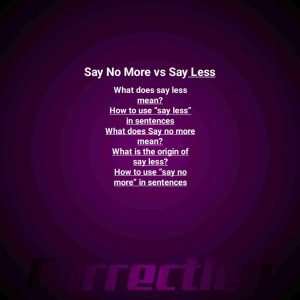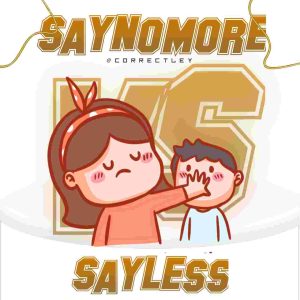You probably already have an argument with this article, right from the topic. Everyone does. I do too. ‘Say less’ and ‘Say no more’ mean the same thing. Maybe they do but not everyone takes the two statements as the same. There are slight differences between the two and clear similarities.
The difference between the two phrases is ‘Say Less’ is often interpreted as an extreme version of ‘Say no more’.
‘Say Less’ is also often used literally to shut a person up when you are not willing to listen.
What does ‘Say Less’ Mean?
The phrase ‘say less’ is thought to have been first used in the early 2000s in the hip-hop and rap culture. It was initially used to express surprise or disbelief and has since become commonplace in spoken language, with various interpretations of its meaning ranging from an advice to speak less, to an acknowledgement that no more needs to be said.
‘Say less’ is a phrase used to mean ‘I understand’ or ‘I get it’. It is also used to mean ‘Stop talking about this’ or ‘Change the topic’.
The meaning of ‘Say less’ is quite clear but it is often interpreted as rude. Asides from it being an informal expression, it is literally interpreted to mean a person has said too much already and you are trying to shut the person up.
‘Say less’ means a person understands the instructions or rules that is being given to him or her without further explanations. It can come in the middle of a person’s speech. In that case, it means the person does not have to say much further since you already understand what he or she means and where the speech will end.
A person can tell you ‘Say less’ while you are arguing against his or her point or giving some advice. This is definitely rude since it dismisses what you have to say.
Whether in an argument or while you are receiving instructions, you should only say this to someone you are familiar with.
How to use ‘Say Less’ in a sentence.

You can use ‘Say less’ in text messages and on social media but only when you are referring to people who understand your language. By ‘people who understand your language’, I mean young people who are familiar with slangs and other informal expressions like this one.
It does not have to be part of a sentence. Saying this alone will pass the message that you need it to. You can say this in response to an instruction, a law, a statement of fact, or a person’s opinions.
As long as you are referring to members of Generation Z, you will have no problem in being understood. However, you should avoid informal expressions which are easily misinterpreted- like this one- when you speak to older people.
To reduce the risks of being misinterpreted or, at least, appear more polite, you can add a few more words as shown in the examples below;
- “Say less. I’ll get it done.”
- “Say less. I understand now.”
- “Say less. I’ll blow your mind.”
- “Say less. I have your back.”
- “Say less. You have nothing to worry about.”

What does ‘Say No More’ mean?
As mentioned earlier, this expression is extremely similar to ‘Say less’. Rather, we can consider ‘Say less’ similar to ‘Say no more’ since the phrase only became popular in the ‘90s. The phrase ‘say no more’ has been around for much longer.
Though the exact origin of ‘Say no more’ is unknown, it has been around for centuries. It is believed to be derived from the popularly used Latin phrase ‘dic ne amplius’, which translates to ‘say no more’. The phrase is believed to have originated as a way for someone to politely decline a request or suggestion without giving further explanation.
In contemporary conversations, it is commonly employed as an acknowledgement of understanding or agreement with the speaker without requiring any additional dialogue on the subject.
The phrase ‘Say no more’ has many potential sources and meanings, depending on its usage in a given context. We can also trace its origin as far back as the 16th century England, where it was often used by aristocrats and members of the upper classes as they communicated with each other.
In this period, it was often used as an expression implying that one had already said enough, or had made their point clear. While its meaning has evolved over time, and is now commonly used informally in everyday conversation to indicate understanding or agreement between two parties.
Being informal, this commonly used expression can be interpreted as being rude if you are saying it to an old person who is not familiar with slangs.
While the expression truly dates back, it is no longer used in its original meaning and may arguably have gone out of use if it wasn’t adopted informally.
This phrase is more common in spoken conversations, rather than in text messages and social media, though it is not wrong if you use it in a text. Below are conversations in which ‘Say no more’ may appear.
What is the origin of ‘Say Less’?
One can argue that ‘Say less’ was formed from the old saying ‘Say no more’ since the two phrases are used similarly. However, we can’t reach a conclusion on this.
‘Say less’ is a phrase which may have originated from African-American Vernacular English within the late ‘90s and the early 2000s. It was popularized in hip hop culture as an idiom used to emphasize the importance of being cautious with one’s words and not sharing too much about yourself.
The phrase acts both as a warning to others and an expression of solidarity. ‘Say less’ communicates that there is one thing which should always be respected which is one’s privacy.
How to use ‘Say No More’ in a sentence
This idiom is mostly used in spoken conversations. However, as mentioned earlier, nothing stops you from using this in text messages and on social media. Despite this being an old phrase, it may still be considered disrespectful by old people so you may want to beware of whom you use this with.
The idiom, “Say no more”, is used to indicate that one already knows what the other person is implying or referring to and does not need any additional information or explanation.
For example, if you are asked “Do you understand the previous explanation I gave on…?” you could respond with “Say no more” as a way of expressing understanding without needing further elucidation. That is one way to use this phrase.
It can simply be used to agree that another person does not have to say anything more about a topic For example: “I know you don’t want to talk about it – say no more.”
Another way to use this phrase is to call off a person’s bluff. If a person appears to be lying to you and you are sure of it, you can simply tell the person to ‘Say no more’. This implies that you already have the information you need and what the person has to say is needless to you.
You can use this response when you are receiving instructions from a person. You may be receiving a project with a set of guidelines to follow. You can say “Say no more” after you’ve gotten all the instructions and information you need.